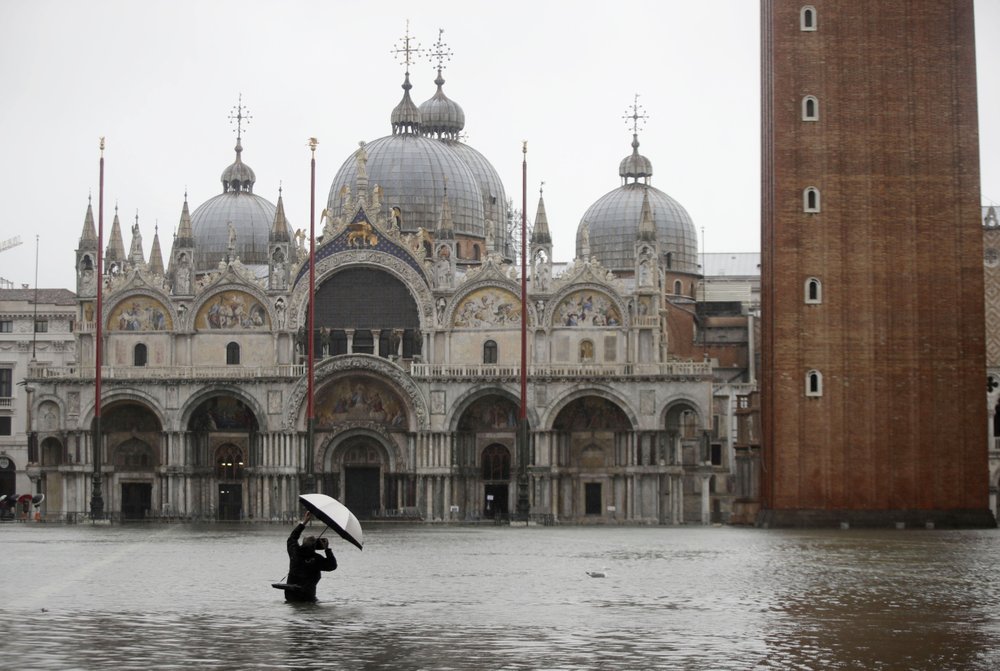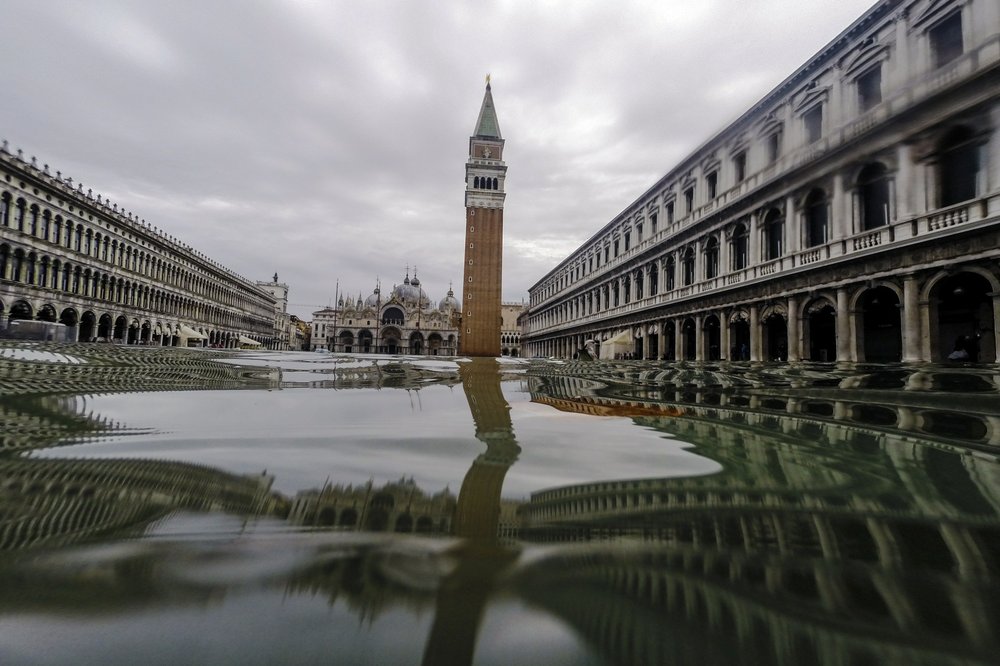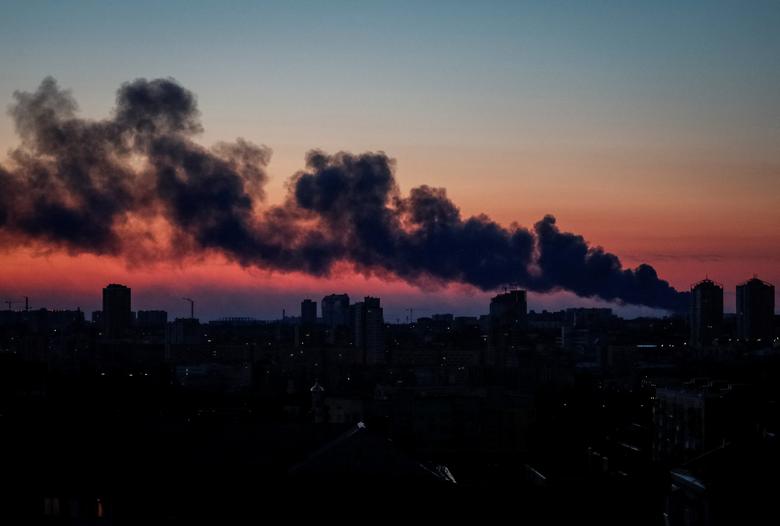Venice sees record third exceptional tide – Priceless artwork threatened – “It is a long-term issue. It is not the issue of one flood, we restore, and we go back to normal.”

By Colleen Barry and Luca Bruno
17 November 2019
VENICE, Italy (AP) – Venice was hit Sunday by a record third exceptional tide in the same week while other parts of Italy struggled with a series of weather woes, from rain-swollen rivers to high winds to an out-of-season avalanche.
Stores and museums in Venice were mostly closed in the hardest-hit area around St. Mark’s Square, but tourists donned high rubber boots or even hip waders to witness and photograph the spectacle.
Most were disappointed when officials closed the historic square as winds rippled across the rising waters. The doors of the famed St. Mark’s Basilica were securely shut to the public, an authorities took precautions — stacking sandbags in canal-side windows — to prevent salt-laden water from entering the crypt again.
Venice’s Tide Office said the peak tide of 1.5 meters (nearly 5 feet) hit just after 1 p.m. but a weather front off the coast blocked southerly winds from the Adriatic Sea from pushing the tide to the predicted level of 1.6 meters (5 feet, 2 inches). By early evening, the level was less than a meter (three feet).
Still it marked the third time since Tuesday night’s 1.87-meter flood — the worst in 53 years — that water levels in Venice had topped 1.5 meters. Since records began in 1872, that level had never been reached even twice in one year, let alone three times in one week.
While Venetians had a bit of relief, days of heavy rainfall and snowfall elsewhere in Italy swelled rivers to worrisome levels, triggered an avalanche in the Alps and saw dramatic rescues of people unable to flee rising waters.

In Venice, many store owners in the swanky area around St. Mark’s completely emptied their shops, while others put their wares as high as possible and counted on automatic pumping systems to keep the water at bay. In one luxury boutique, employees used water vacuums and big squeegee mops to keep the brackish lagoon waters from advancing.
Venice’s mayor has put the flooding damage at hundreds of millions of euros and Italian officials have declared a state of emergency for the area. They say Venice is both sinking into the mud and facing rising sea levels due to climate change. […]
The flooding has raised renewed debates about the city’s Moses flood defense project, a corruption-riddled underwater barrier system that is still not operational after more than 16 years of construction and at least 5 billion euros (€5.5 billion) of public funding. It was supposed to be working by 2011. [more]
Time for hip waders: Venice sees record 3rd exceptional tide

Historic flooding highlights Venice’s vulnerability
By Colleen Barry
15 November 2019
VENICE, Italy (AP) – The historic lagoon city of Venice exists on the edge of a double threat: As it sinks, the seas rise.
That reality became more stark this week when Venice was hit with its worst flood in over 50 years, caused by a nearly 1.9 meter (6-foot) tide that sent waist-high water flowing through St. Mark’s Square, cast the city’s world-famous gondolas onto walkways, and threatened its medieval, Baroque and Renaissance art and architecture.
Damage to the City of Canals from the second-worst flood ever recorded was put at hundreds of millions of euros (dollars).
Against the backdrop of the disaster, a corruption-riddled underwater barrier system that was supposed to protect the city still is not operational after more than 16 years of construction and at least 5 billion euros of public funds. It was supposed to be working by 2011.

“It has been a generation of panels and engineers that have been working on it. No one can actually tell if it will actually be operational,” said Mechtild Rossler, director of the UNESCO World Heritage Center in Paris, which lists Venice as one of its legally protected World Heritage sites because of its cultural and historical significance.
Called Moses — from the Italian acronym for experimental electromechanical modules, but also a nod to the biblical figure who parted the Red Sea — the system of 78 underwater barriers is designed to be raised as needed to block openings to the lagoon and hold back tides of 1.1 to 3 meters.
That would still leave exposed the lowest areas of the city, or about 12% of its area, including St. Mark’s Square.
Though nearly completed, the project still has not been even partially tested, and some parts have already started to corrode. It has also been marked by bribery scandals and overruns. Its initial costs were projected at 1.6 billion euros.

Even with the emergency, Moses won’t be operational before the end of next year.
At the same time, the threats to the city of a quarter-million people are growing.
While the latest round of flooding has been attributed mostly to a combination of high tides from a full moon and high winds pushing water from the shallow Adriatic Sea into Venice, climate scientists note that exceptional tides — those over 1.4 meters — have become much more frequent in the past two decades.
Of the 20 exceptional tides recorded from 1936 through Tuesday’s, more than half have occurred since 2000.
“It is a long-term issue. It is not the issue of one flood, we restore, and we go back to normal,” Rossler said.
Climate scientist Stefan Rahmstorf of the University of Potsdam estimates that one-third of Venice’s increasing vulnerability is due to global warming, which has raised the sea level.
“The rest is mostly man-made,” he said.
The 1,600-year-old city is built on uncompacted sediment, which is settling. Venice’s Tide Office said that because of the combined effect of the city’s settling and the rising of the sea, the water is now 30 centimeters (12 inches) higher against the buildings than it was when record-keeping began in 1873.
About 10 to 11 centimeters of that took place since the last big flood, in 1966. [more]



